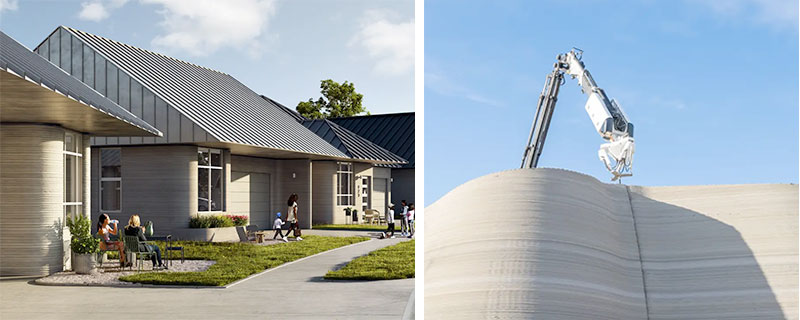Removing the Roadblocks to 3D Housing in Texas
Images: Icon
Over the last few years, several new startups have promised to build better homes using less labor, time, money, and materials — all with the help of a piece of technology: a 3D printer.
But amid this quest to alleviate the US housing crisis, the nascent 3D printing construction industry has continued to face major roadblocks.
A construction-tech startup in Austin now says it has the solutions.
On Tuesday, Icon announced four products that could help solve for 3D printing construction companies’ biggest pain points: a multi-story printer, a “low-carbon” concrete mix, a digital catalog of designs, and an AI printed-home designer.
In the last few years, startups — and even colleges — have unveiled 3D printed dwellings around the US.
In Virginia, Alquist, a 3D printing construction company, has built three Habitat for Humanity houses using a 3D printer.
In Texas, Icon is now working with construction giant Lennar to build the world’s largest printed neighborhood.
And in Maine, a state university is now scaling up its manufacturing space to increase its production of fully recyclable printed dwellings.
But their lofty goal of mass-producing affordable homes still faces some big problems, including an underdeveloped workforce, the tech’s inefficiencies and limitations, and the sky-high cost of materials and printers.
On the latter note, most construction printers extrude a cement mix. However, concrete is far from being environmentally friendly.
Think of it as a 3D printing home starter kit — starting with Icon’s new printer, Phoenix.
Many 3D printed family homes — including Icon’s previous builds — are single-story, with the only printed components being its walls.
The rest of the house has to be built traditionally.
The “six-degree robotic arm” can create a multi-story building’s foundation, walls, floors, and roof structures without stopping, Melodie Yashar, Icon’s vice president of building design and building performance, told Business Insider.
Jason Ballard, cofounder and CEO of Icon, stated that a Phoenix-built wall systems and foundations are estimated to be about 30% less expensive than conventional homebuilding methods.
Regarding speed, he said the timeline for completing a home’s printed elements could be “twice as fast as traditional construction.”
Despite its widespread use, concrete isn’t great for the environment: The global production of cement, which is an ingredient of concrete, makes up 8% of the world’s carbon emissions, triple the aviation sector’s global output, The Washington Post reported.
Like other cement mixes made for 3D printers, CarbonX would still be fireproof, mould-proof, and insect-proof.
The formula would be available to other homebuilders in April, with more environmentally friendly mixes already in Icon’s pipeline.

“Many times, developers, builders, and city planners come to us and don’t know where to start,” Yashar said. “They don’t know what’s possible in terms of designs or the best product for them.”
To help with this, Icon created Codex, a digital catalog of printed home designs.
Avant-garde, as in some buildings are U-shaped, Yashar said. Others were designed to be “very affordable” — some of the units could be built for $99,000 or less.
To compare, the startup’s first six builds in its upcoming 100-home neighborhood were listed between $476,000 and $566,000.
Developers can then browse this catalog, select their preferred designs, and tap Icon to build these properties.
They can then either send Icon a deposit on the model (if there’s already one ready to purchase) or join a waiting list that would alert them if their ideal design has hit their market.
Some of Icon’s projects, including those at its development in Marfa, Texas — where homes “start in the upper $900,000s,” according to Icon’s website — will be available through Codex.
Yashar said Vitruvius, an AI-based system, was created to “democratize” Icon’s design process. However, the company didn’t say how much it would cost to use the tech, which is still in beta.
When it’s complete, people can use Vitruvius to create floor plans and renderings — while considering requirements like budgets and permits — of their ideal printed residence.
“In the future, I believe nearly all construction will be done by robots, and nearly all construction-related information will be processed and managed by AI systems,” Icon’s CEO said in a release.
Architects could use Vitruvius to “accelerate” the home design process.
“I want to build a better world faster and cheaper,” Icon cofounder in 2022.
Two years later, with the release of this new suite of products, it seems Ballard could still be on track with his goal.
Source: Business Insider






Leave a Reply
Want to join the discussion?Feel free to contribute!